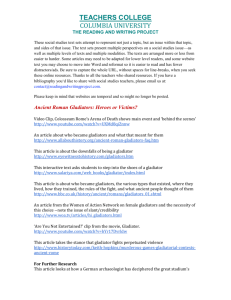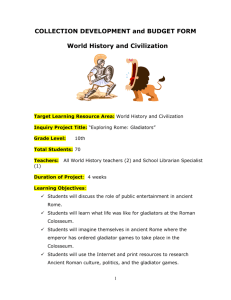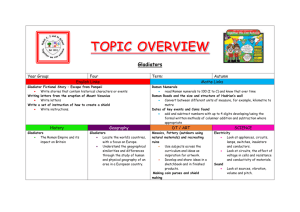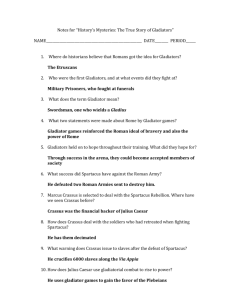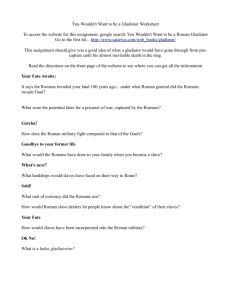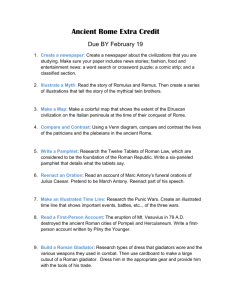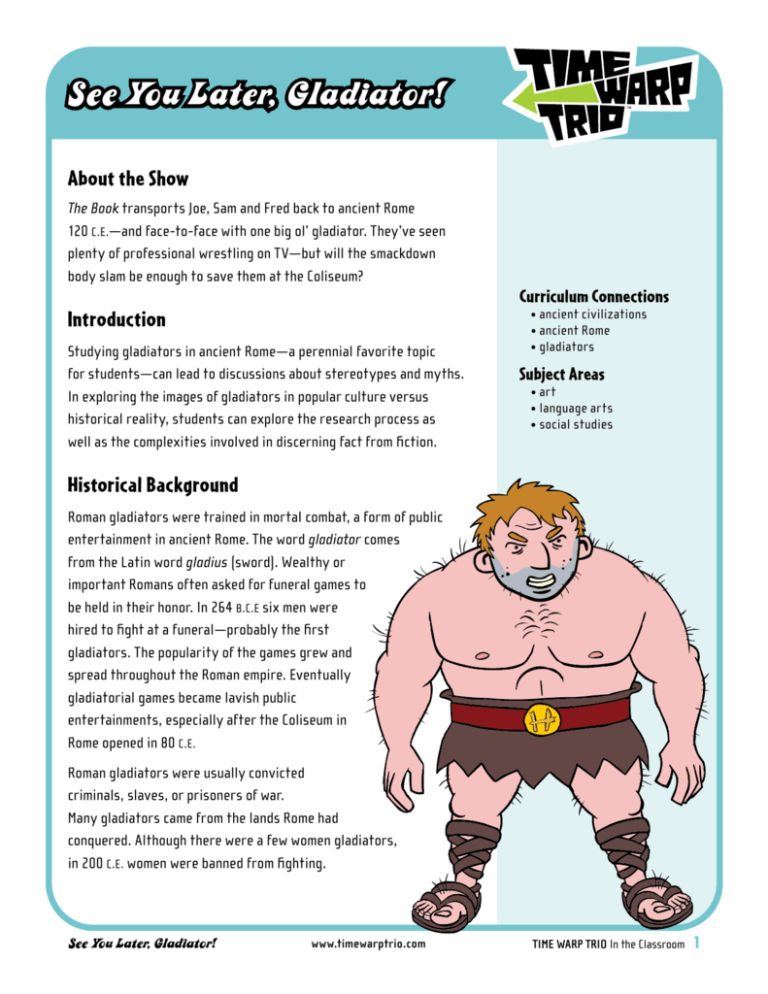
See You Later, Gladiator!
About the Show
The Book transports Joe, Sam and Fred back to ancient Rome
120 C.E.—and face-to-face with one big ol’ gladiator. They’ve seen
plenty of professional wrestling on TV—but will the smackdown
body slam be enough to save them at the Coliseum?
Curriculum Connections
Introduction
Studying gladiators in ancient Rome—a perennial favorite topic
for students—can lead to discussions about stereotypes and myths.
In exploring the images of gladiators in popular culture versus
historical reality, students can explore the research process as
well as the complexities involved in discerning fact from fiction.
• ancient civilizations
• ancient Rome
• gladiators
Subject Areas
• art
• language arts
• social studies
Historical Background
Roman gladiators were trained in mortal combat, a form of public
entertainment in ancient Rome. The word gladiator comes
from the Latin word gladius (sword). Wealthy or
important Romans often asked for funeral games to
be held in their honor. In 264 B.C.E six men were
hired to fight at a funeral—probably the first
gladiators. The popularity of the games grew and
spread throughout the Roman empire. Eventually
gladiatorial games became lavish public
entertainments, especially after the Coliseum in
Rome opened in 80 C.E.
Roman gladiators were usually convicted
criminals, slaves, or prisoners of war.
Many gladiators came from the lands Rome had
conquered. Although there were a few women gladiators,
in 200 C.E. women were banned from fighting.
See You Later, Gladiator!
www.timewarptrio.com
Time Warp Trio In the Classroom
See You Later, Gladiator!
Historical Background
continued
Some gladiators who managed to survive the fierce fighting became famous or even wealthy. Men
of the very lowest social rank sometimes bound themselves to the owner of a gladiator troupe, enduring
branding, chains, flogging, and brutality at the hands of their masters to become gladiators. Gladiators
went through intense training and were taught complex moves so they could better entertain
the audience.
Gladiators were supposed to fight to the death, but if they fought extremely well the crowd could
decide to spare both fighters. The crowd voted by showing thumbs up or thumbs down—although
whether or not thumbs up meant “life” has not been verified. Sometimes gladiators won prize money.
At a large event there could be hundreds of gladiators. In the Coliseum, the audience could be as
large as 50,000 people. After other entertainments in the morning, such as hunting wild animals and
the execution of criminals, gladiators would enter the arena. They would approach the emperor and
proclaim, Ave, Imperator, morituri te salutamus (Hail, Emperor, we who are about to die, salute you).
As Christianity spread and the power of the Roman Empire declined, the appeal of the games diminished.
In 326 C.E. Constantine began the process of abolishing gladiator games. In 400 C.E. Emperor Honorius
banned gladiators forever.
re
Want students to get even mo
excited about hi story?
Check out the gladiators adventure for kids at
www.timewarptrio.com/adventures/gladiators/
Sandwiches of Time and other interactive games to play.
P lentifax 487—the ultimate time traveler’s guide—to find out how
gladiators lived and fought!
Cool Books that kids will love.
See You Later, Gladiator!
www.timewarptrio.com
Time Warp Trio In the Classroom
Activity 1
Let The Games Begin!
Students compare what they think they know about
gladiators with facts they learn through research. They then
use the information to act as reporters and write an article
about a gladiatorial game.
Objectives
Instructions
1. B oth the book and the show See You Later, Gladiator portray Horridus
as a laughable figure, but being a gladiator was not so funny. Ask students
to volunteer what they already know about gladiators. Create a twocolumn chart entitled Gladiators. Label one column “Fact” and the other
column “Fiction.”
2. Divide the class into small groups. Explain that students will be researching
gladiators, the conditions under which they lived and fought, and how they
have been portrayed in books, movies, and legends.
3. After students share what they have learned, revisit the chart. Which
items are facts? Fiction? Add new information to the chart and discuss the
differences between the fictional portrayals and real gladiators.
4. A sk students to act as reporters and write an article describing
a gladiatorial game they have just seen. Encourage students to include
as many details as possible about the crowd, the events of the day,
the emperor, the outcome of the games, what the gladiators wore, what
nationality they were, etc.
5. Y ou may want to offer students the option of being sportscasters.
Working in pairs, students can interview a gladiator after a game. They
will need to convey the information they have learned as they ask
and answer questions. (Students may want to write a script of the
interview beforehand.)
• t o expand students’ knowledge
of ancient Rome and gladiators.
• to practice research skills
Materials
• art and writing supplies
• chart paper and easel
Curriculum Standards
• NCSS
Individuals, Groups, and
Institutions: Students
demonstrate an understanding
of concepts such as role, status,
and social class in describing the
interactions of individuals and
social groups.
• NCTE/IRA
Students use spoken, written,
and visual language to
accomplish their own purposes
(e.g., for learning, enjoyment,
persuasion, and the exchange
of information.)
Take It Further
Have the students work together to create a mural of an ancient Roman
town with a stadium on game day.
See You Later, Gladiator!
www.timewarptrio.com
Time Warp Trio In the Classroom
Activity 2
Gladiator “Step” Book
This activity helps students use similes in their writing and
then present their knowledge about gladiators in the form of
a “step” book.
Instructions
1. A sk students to use their imagination to visualize how a gladiator looks,
sounds, smells, etc.
2. A sk the students the following questions. Encourage a wide variety of
answers. Record their responses on the board.
• What do gladiators look like?
• What do gladiators sound like?
• How do gladiators smell?
• How do gladiators eat?
• What might a gladiator feel like?
Objectives
• t o improve students’
understanding and use
of language
• t o create similes
• t o expand students’ knowledge
of ancient Rome
Materials
3. Distribute three sheets of paper to each student. Show students how to
arrange the paper so they have a one-inch overlap on each page. Each flap
is a “step.” Demonstrate how to fold the paper into a six-page “Step” Book
Illustration: How to Make a Step Book
© 2002 by Tarry Lindquist from Seeing
the Whole Through Social Studies,
Second Edition. Portsmouth, NH:
Heinemann.
• art and writing supplies
• 3 sheets of white 8 1/2” x 11”
paper per student
Curriculum Standards
• NCSS
Individual Development and
Identity: Students relate such
factors as physical endowment
and capabilities, learning,
motivation, personality,
perception and behavior to
individual development.
• NCTE/IRA
Students apply knowledge of
language structure, language
conventions, (e.g., spelling and
punctuation, media techniques,
figurative language, and genre)
to create, critique, and discuss
print and non-print texts.
See You Later, Gladiator!
www.timewarptrio.com
Time Warp Trio In the Classroom
Activity 2
4. Have students write the title of their “Step” Book on the first page.
Have students label each “step” with one of the following sentences.
• G ladiators look like
• Gladiators sound like
• G ladiators feel like
• G ladiators smell like
• G ladiators eat like
5. A sk students to complete each sentence and then draw a picture to go
with it. You can also give examples, such as:
• Gladiators look like mice caught in a giant cage.
• Gladiators sound like monster trucks at an indoor rally.
• Gladiators feel like gristle on a bone.
• Gladiators smell like three-day-old meat.
• Gladiators eat like hungry bears at the end of their hibernation.
6. E xplain to students that they have been writing similes—a figure of
speech that makes a comparison using either like or as. Writers use
similes to make their descriptions richer.
7. H ave students read each other’s “Step” Books.
8. A sk students to notice similes in the books they read. For example, on
page 83 of See You Later, Gladiator Jon Scieszka writes, “The green time
mist slipped away like air leaking out of a tire.” Challenge your students
to find other similes as they read this or other books.
See You Later, Gladiator!
www.timewarptrio.com
Time Warp Trio In the Classroom
Resources
Recommended Books
For Teachers
For Students
As the Romans Did: A Sourcebook in
Roman Social History, second
edition, by Jo-Ann Shelton.
(Oxford University Press, 1997)
A wide array of documents, from
letters to recipes to graffiti, reveals
extensive information on the lives of
the average Roman.
Fiction
Daily Life in Ancient Rome: The
People and the City at the Height of
the Empire by Jerome Carcopino.
(Yale University Press, 2003)
A classic account of imperial Rome,
using primary source materials.
Atticus of Rome, 30 B.C.
by Barry Denenberg. (Scholastic, 2004)
Sold into slavery by Roman soldiers,
Atticus uncovers a plot to murder the
emperor, and finds his father, now a
gladiator.
The Greenwood Encyclopedia of
Daily Life, Volume 1 edited
by Joyce E. Salisbury. (Greenwood
Press, 2004) A comprehensive look at
the lives of ordinary people in ancient
times—their clothes, food, culture,
customs, beliefs, etc.
Detectives in Togas
by Henry Winterfield. (Harcourt, 2002)
Rufus may make mischief, but he is
not a robber or defiler of the Temple
of Minerva. It’s up to his classmates
to prove his innocence.
Handbook to Life in Ancient Rome
by Lesley Adkins and Roy Adkins.
(Oxford University Press, 1998)
An overview of the Roman world,
illustrated with photographs, maps,
and line drawings.
The Penguin Historical Atlas of
Ancient Rome by Christopher Scarre.
(Penguin, 1995) This book explores the
growth of the Roman empire and
its legacy.
See You Later, Gladiator!
The Assassins of Rome
by Caroline Lawrence. (Roaring
Brook, 2002) The Roman Mysteries
series. Flavia and Nubia follow their
friend Jonathan on a secret mission to
Rome and the Golden House of
Emperor Nero.
The Silver Branch by Rosemary
Sutcliffe. (Farrar, 1993)
Two cousins join the Roman army
to fight against a cruel British leader.
See also The Eagle of the Ninth and
Outcast by the same author.
The Thieves of Ostia
by Caroline Lawrence. (Roaring Brook,
2001) The Roman Mysteries series.
Flavia, a sea captain’s daughter, is
determined to discover who is killing
dogs in 1st century Rome.
Nonfiction
The Ancient City: Life in Classical
Athens and Rome by Peter Connolly
and Hazel Dodge. (Oxford University
Press, 2000) A description of
everyday life in classical Greece and
ancient Rome, illustrated with fullcolor drawings.
Galen, My Life in Imperial Rome
by Marissa Moss. (Silver Whistle, 2002)
This notebook-style book combines
fact and fiction in telling the story of
a 12-year-old slave.
Ancient Rome by Simon James.
(DK, 2000) Eyewitness Reference
series. This book provides
information about ancient Rome
through drawings, maps, captions,
and photographs.
Rome Antics by David Macaulay.
(Houghton Mifflin, 1997)
A homing pigeon provides a bird’s eye
view of the most famous
constructions of the ancient Romans.
Ancient Rome Revealed
by Peter Chrisp. (DK, 2003)
Transparent overlays show the inside
story of the Roman Empire at its
height of power.
See You Later, Gladiator
by Jon Scieszka. Illustrated by Adam
McCauley.(Puffin, 2002)
Can the Trio make it through gladiator
school and win in the Coliseum?
Emperors and Gladiators
by Anita Ganeri. (Peter Bedrick
Books, 2001) Investigate some of the
job opportunities open to ancient
Roman citizens, from soothsayer to
vestal virgin.
www.timewarptrio.com
Time Warp Trio In the Classroom
Resources
Gladiator by Richard Watkins.
(Houghton Mifflin, 2000) This book
offers an in-depth look at the lives
of gladiators.
Gladiator’s Secret by John Malam.
(Gareth Stevens, 2004)
This fictional story about a young
museum volunteer on a fact-finding
trip to Europe includes pictures,
diagrams, and facts about a
gladiator’s life.
The Roman Colosseum
by Elizabeth Mann. (Mikaya Press,
1998) A look at ancient Roman
civilization as embodied by the
Colosseum and its famous games.
The Roman News by Andrew Langley.
(Gareth Stevens, 2000)
Presents details of daily life in
ancient Rome in a humorous
newspaper format.
Spend the Day in Ancient Rome:
Projects and Activities That Bring
the Past to Life by Linda Honan.
(Wiley, 1998) Ideas for crafts and
other activities that give readers
a taste of life in Rome in 125 C.E.
You Wouldn’t Want to Be a Roman
Gladiator! Gory Things You’d Rather
Not Know by John Malam. (Franklin
Watts, 2000) This light-hearted
book offers facts about gladiators
with cartoon illustrations.
Poetry
Ancient Rome by Susan Altman and
Susan Lechner. (Scholastic, 2001)
Buildings, residents, and activities
of ancient Rome are the inspiration
for 27 brief poems.
Web sites
The Gladiator
ablemedia.com/ctcweb/consortium/
gladiators.html
This site, part of the Classics
Technology Center, offers free teaching
and learning materials created by
teachers and students.
Rome: Colosseum
greatbuildings.com/buildings/
Roman_Colosseum.html
A brief look at the Colosseum with
photographs, architectural drawings,
3-D models, and historical facts.
Secrets of Lost Empires: Roman
Bath
pbs.org/wgbh/nova/lostempires/
roman/
This companion site to the PBS
series Secrets of Lost Empires offers
timelines and classroom resources.
Includes detailed information about
the famous Baths of Caracalla,
a challenge to build a successful
Roman aqueduct, and recipes.
TIME WARP TRIO
www.timewarptrio.com
This site for kids includes interactive
games, fascinating facts, and booklists
that help make the past come alive.
Please note:
Although these sites were verified at the time
of publication, Web site addresses and content
are frequently subject to change.
The Roman Empire in the First
Century
pbs.org/empires/romans/
This companion site to the PBS
series offers information, timelines,
and classroom resources. Includes
a simulation that explores leadership
and the difficulties leaders face
when making decisions.
Roman Gl adiatorial Games
depthome.brooklyn.cuny.edu/
classics/gladiatr
Created by the Brooklyn College
Classics Department, this site offers
detailed information about gladiatorial
games, gladiators, and emperors.
©2005 WGBH Educational Foundation. All rights reserved. Time Warp Trio™ is produced by WGBH in association with Soup2Nuts for Discovery Kids.
Major funding was provided by a grant from the National Endowment for the Humanities. Any views, findings, conclusions, or recommendations expressed in these classroom materials do not necessarily
represent those of the National Endowment for the Humanities. Based on THE TIME WARP TRIO book series written by Jon Scieszka and illustrated by Lane Smith.
Time Warp Trio is a registered trademark of Chucklebait, LLC. Used with permission. Third party trademarks are the property of their respective owners. Used with permission.
See You Later, Gladiator!
www.timewarptrio.com
Time Warp Trio In the Classroom


